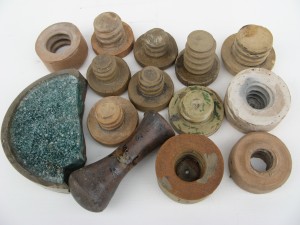 Earlier this year I had an email from a chap from Burton- in-Lonsdale called Peter who claimed to have found some old pottery equipment in a cellar that he didn’t know was there. He sent me the following photograph of a selection of the items and asked me if I would like him to call around to the pottery with the collection of things he had uncovered. I was delighted for him to call into the pottery and look at this treasure.
Earlier this year I had an email from a chap from Burton- in-Lonsdale called Peter who claimed to have found some old pottery equipment in a cellar that he didn’t know was there. He sent me the following photograph of a selection of the items and asked me if I would like him to call around to the pottery with the collection of things he had uncovered. I was delighted for him to call into the pottery and look at this treasure.
It turned out the cellar had been discovered when Peter was having his central heating plumbed in. The plumber had removed some floorboards to locate and install new pipework when he discovered a void. I guess it would have made the plumber’s life a lot easier, as he would have been able to go into the cellar and work on the pipes standing up. An entrance to the cellar was discovered from the inside which leads to the front garden via a buried doorway (hence he didn’t know he had the cellar, as the entrance was covered!)
The cellar is stone built with a fireplace and recessed stone shelving and strangely had a large pile of rubble against one of the walls. Peter made plans to extend his house downwards and it was whilst the builders were extracting the rubble from the cellar floor that they came across the old pottery equipment. How and why it ended up in the pile of rubble is a mystery.
Burton-in-Lonsdale has a long history of pottery industries, particularly the manufacture of stoneware bottles. Some of these bottles had screw lids with leather washers that sealed the contents. It is my guess that what Peter had found among other things are some moulds for the manufacture of the screw part of the bottle. One mould makes the stopper (male screw) and the other mould makes the screw in the bottle (female screw). Now being a potter myself I was keen to attempt to make a screw top bottle of my own using these old moulds. Here is a photo sequence of me doing this:
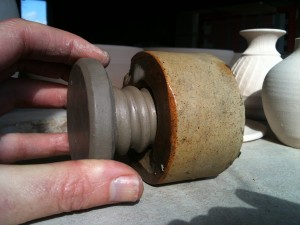
Here I have pressed clay into the mould and then stuck a clay disc onto the top. The mould was first lubricated with oil, so the clay won’t stick to it. It was then left overnight to dry and then unscrewed the next morning.
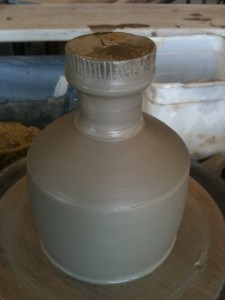
I threw a bottle shape and then enclosed the mould inside the neck of the bottle. The mould was first coated with oil to act as a resist.
I’m fairly convinced that the stoppers were made as in the photographs. I’m not as convinced that the screws were put into the bottles using the method I have shown (any views on this would be appreciated), however the method I used did work. I did wonder if the moulds for making the screw in the bottle were in fact bottle stoppers? One of the female moulds and one of the male moulds had the letter “R” carved into the side as if they were a matching pair for creating the thread in the bottle and the bottle stopper (they did screw into each other).
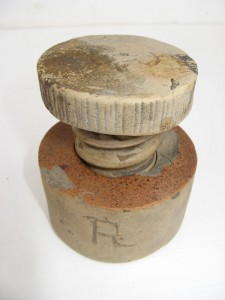
Notice the “R” scratched into both moulds. All the moulds appeared to have been made from clay. Some have been high fired and some have been low fired.
Besides the screw moulds, a number of other objects were found:
- There was a pestle that looked as though it had been broken and fixed again by applying glaze to act as glue and then re-firing (only a potter would do this!). It is possible that the pestle could have been used for grinding glaze ingredients?
- What looks like the broken bottom of a stoneware bottle filled with an inch of glass. This is another mystery. The only way I can think that this could have been made is by filling the pot with broken glass prior to firing, so that during the firing the glass melts and forms a pool or by mixing dry glaze ingredients into the bottom of the pot and then firing so the pot acts like a crucible for the molten glaze ingredients? Could this have been glass frit manufactured at Burton for adding to glaze? I am totally confused by this.
- A stoneware bottle stamped with a “W” and marked close to the base with “Bateson’s 1914”. Now the name Bateson was a common name in the Burton potteries. Does the “Bateson’s” refer to one of the Bateson’s potteries e.g Waterside Pottery which was run by William Bateson and sons, or did the “Bateson’s “ refer to the company that sold their product in the bottle? It was uncommon for the Burton potters to put their name on a pot and when they did it was usually on the base of a pot and not on the side?
- A metal wheel with a shaft coming out and a wooden top. Could this have been a pottery wheel, or a banding wheel, or is this just wishful thinking on my part? The wheel has a ring of lead attached to it. Could this have been to aid momentum? I struggle to see what else this object could be.
Could the cellar have been used as a small scale pottery workshop? This is a possibility, there is no evidence of a kiln in the building, but there were certainly several kilns in the neighbourhood. Perhaps the person that lived here produced work at home and had some arrangement with a local potter whereby he could fire his pots in their kiln? Perhaps the cellar was for manufacturing stoppers. In my discussions with the Bateson family I remember talk of a chap who I think was called Richard Bateson, who was known locally as “screw Dick” because his job was to make the screws and stoppers for the bottles at Waterside Pottery. Could this have been Screw Dick’s screw making cellar? Could this have been a small workshop for making the screw moulds? Perhaps the cellar had nothing to do with the pottery industry and the moulds were just accidentally included in the rubble?
How did the rubble end up in the cellar? Why was the only entrance blocked up? The house was once attached to a larger house next door. At some stage in the past they must have decided to make it a separate house. Maybe they just didn’t like the look of a doorway leading down steps into a cellar and just decide to bury it?
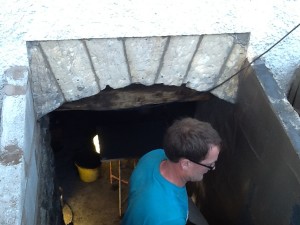
View of excavated doorway into cellar. The stone arch was only discovered when the pebble dashing was knocked off.
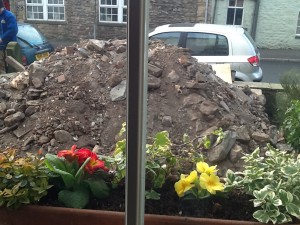
Unfortunately I have no picture of the rubble in the cellar. This is what it looked like once it had been taken out of the cellar!
Perhaps the owner of the house prior to it being split in two owned one of the Burton potteries and simply stored some pottery related items in the cellar?
This find has certainly proved interesting and seems to have raised more questions than answers. Unfortunately most of the people that could provide the answers are no longer around. If anyone can shed any light on these findings, I would be very grateful to hear from them.
If you enjoyed reading this article, then you maybe interested in reading about the last potter of Burton-in-Lonsdale.

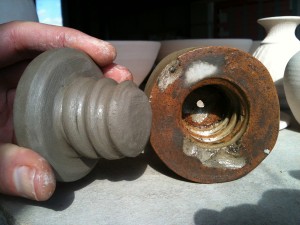
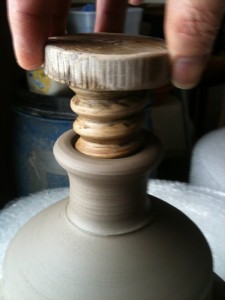
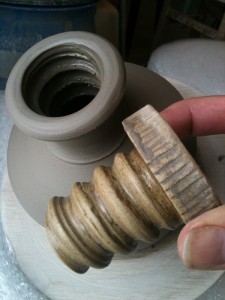
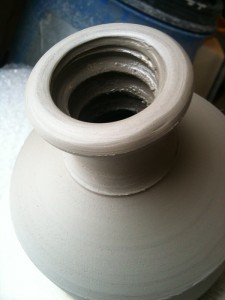
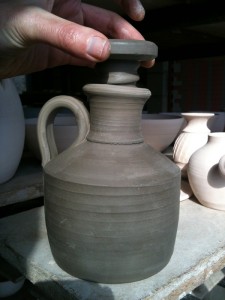
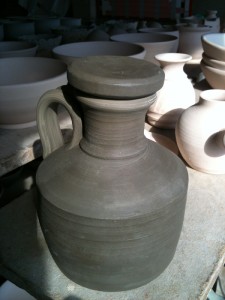
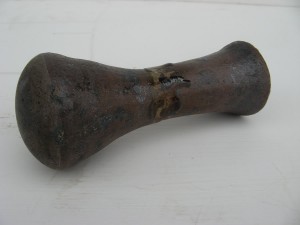
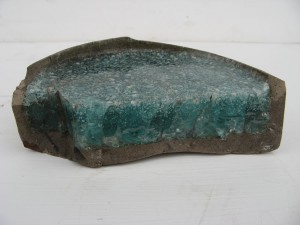
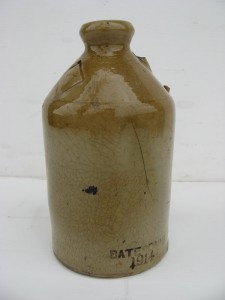
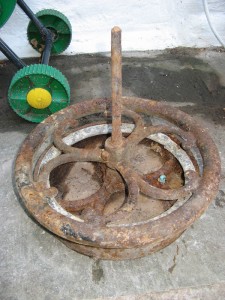
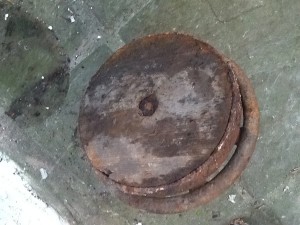
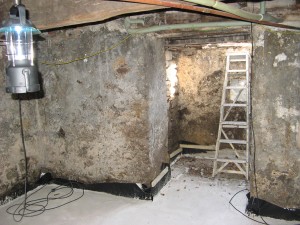
fascinating article Lee
What an interesting find and great story. I’m sorry I can’t assist with any of your questions but do post any updates you get! Maybe you could send your link to someone at the V&A or somewhere like that to see if you can get their opinion?
Just looking at that lump of glass makes me want to crush some up and pop it into some pot fragments in my next firing! Very appealing …
I love this story!
Interesting enough. I have the same stoneware bottle I collected during a summer yard sale from a older couple in Alberta, Canada. I was curious about its origin and came across your posting when Googled it. Fascinating!